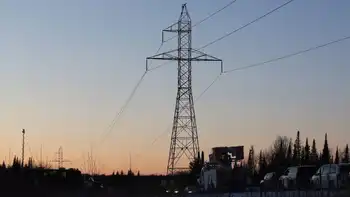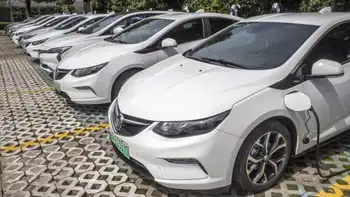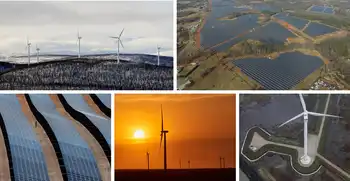Ending India's energy drought
INDIA - In most Indian cities, being middle class means owning your own power company. As summer temperatures approach 40 degrees Celsius (104 Fahrenheit), energy demand from electric fans and air conditioners is putting stretched utilities under stress.
Against a peak demand of 104,000 megawatts last month, supply was 90,000 megawatts.
That is a shortfall of 14 percent.
Rationing of power, which goes on throughout the year, becomes unbearable during the summer months. People resign themselves to blackouts that sometimes last all day, even longer if overburdened cables burn or aging transformers collapse.
Households and businesses create their own electricity by burning diesel in noisy, inefficient, polluting generators. Those who cannot afford to be power producers buy inverters: chargeable batteries that store power from the utilities for later use.
Businesses have it worse.
An nationwide survey of small enterprises in 2002 cited power shortages as one of the top reasons for industrial sickness, far ahead of labor strife or mismanagement.
Why has India allowed itself to get into this mess?
At the end of last year, China had 622,000 megawatts of generation capacity. A fifth of this - almost equal to India's total capacity built up over decades - was added in 2006 alone.
Why does India not invest more in energy, which is emerging as a major bottleneck for sustaining the current pace of 9 percent annual economic growth?
The seed of India's power crisis was sown in 1977. That was when politicians first came up with the idea of subsidized electricity for farmers to win their votes. Then free power for agriculture became the norm, pushing state-run electricity boards into financial ruin. Not that free power did much for the really poor.
A small farmer in a backward area of Punjab, the second-biggest grain-producing state in India, typically will not have any power connection on his land; he will have to burn diesel. It is a costly proposition.
Had the farmer used electricity instead of diesel to irrigate a rice crop, which is sown around this time of the year, he could have enjoyed one harvest of wheat absolutely free even after paying a reasonable user charge to the utility, according to a study by Varinder Jain, a researcher at the Center for Development Studies in India.
The link between electrical and political power goes beyond farmers. In cities like Mumbai and New Delhi, where private operators - Reliance Energy and Tata Power - are in charge of distribution, squatters steal power from the grid with impunity because politicians need their votes.
Every third Reliance Energy customer in Mumbai lives in a shantytown, where, according to the company's own regulatory submission, pilferage ranges from 15 percent to 70 percent.
No one denies that the poor must get electricity, and perhaps for free. But this is not the way to provide it. Every year, there are reports of short-circuiting in illegal electrical wiring causing fires in unauthorized slums. It will not be any different this year.
India has to adopt a multipronged strategy to end its power drought.
The country has to make better use of the 10,000 megawatts of idle generation capacity. Half of it is going unutilized largely because feedstock is unavailable.
Natural gas prices have tripled in the past five years. At $7.80 per million British thermal units, they are double what Indian gas-fired power plants can afford, given the limits on how much consumers can be charged for electricity.
Pending a meaningful reduction in subsidies, more expensive power must still be produced, but its cost must be passed on to those who can bear it.
Reliance Energy has imposed a "reliability charge" on all users in Mumbai consuming more than 300 units, or kilowatt-hours, of electricity in a month. This levy is meant to compensate the distributor for the higher cost of procuring energy, and to minimize disruptions in an extremely tight supply situation.
These measures, however, will not be sufficient to take care of future demand. For that, the solution is quite simple: India has to produce more electricity at affordable rates. And it has to do it rapidly.
A blueprint for that is finally in place.
State-controlled Power Finance Corp. is creating shell companies. The government is offering them coal supplies for 4,000-megawatt plants.
The idea is that once they have obtained regulatory approval, tied up debt financing and lined up customers, these shell companies will be auctioned off. Many of the execution risks - the delays that plague large power projects in India - will be eliminated.
Tata Power bagged one such shell company by bidding a tariff of 2.26 rupees a unit. That compares favorably with the ridiculous 4.25 rupees that the now-defunct energy trader Enron was charging for power from its Indian plant, which had to be shuttered.
On efficiency grounds, nonstate companies must lead the fight against India's energy shortage. Generation units owned by the private sector, operating at 97 percent of their rated capacity last month, are much more efficient than government-owned plants.
As Stanford University economist Frank Wolak puts it: "Until retail prices can be increased to cover total production costs, further investment in new generation capacity using government funds seems imprudent."
The power situation in India will improve. Apart from everything else, there is the big promise of civilian nuclear energy under an agreement that India is negotiating with the United States.
None of this, however, is for the short term. For at least another five years, the middle class will be its own electricity producer of last resort.
Related News

Revenue from Energy Storage for Microgrids to Total More Than $22 Billion in the Next Decade
NEW YORK - A new report from Navigant Research examines the global market for energy storage for microgrids (ESMG), providing an analysis of trends and market dynamics, with forecasts for capacity and revenue that extend through 2026.
Interest in energy storage-enabled microgrids is growing alongside an increase in solar PV and wind deployments. Although not required for microgrids to operate, energy storage systems (ESSs) have emerged as an increasingly valuable component of distributed energy networks because of their ability to effectively integrate renewable generation.
“There are several key drivers resulting in the growth of energy storage-enabled microgrids globally, including the desire to…




